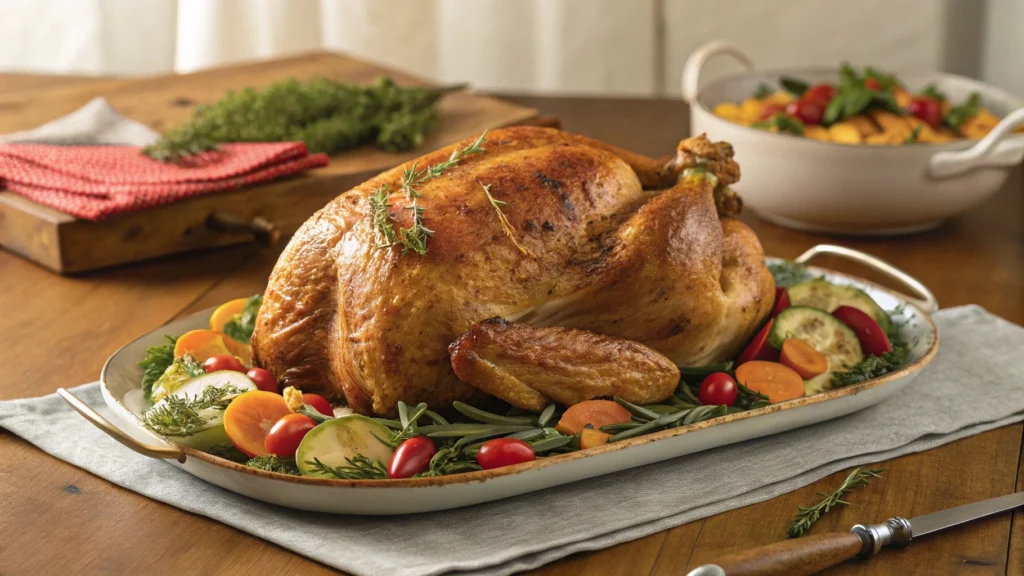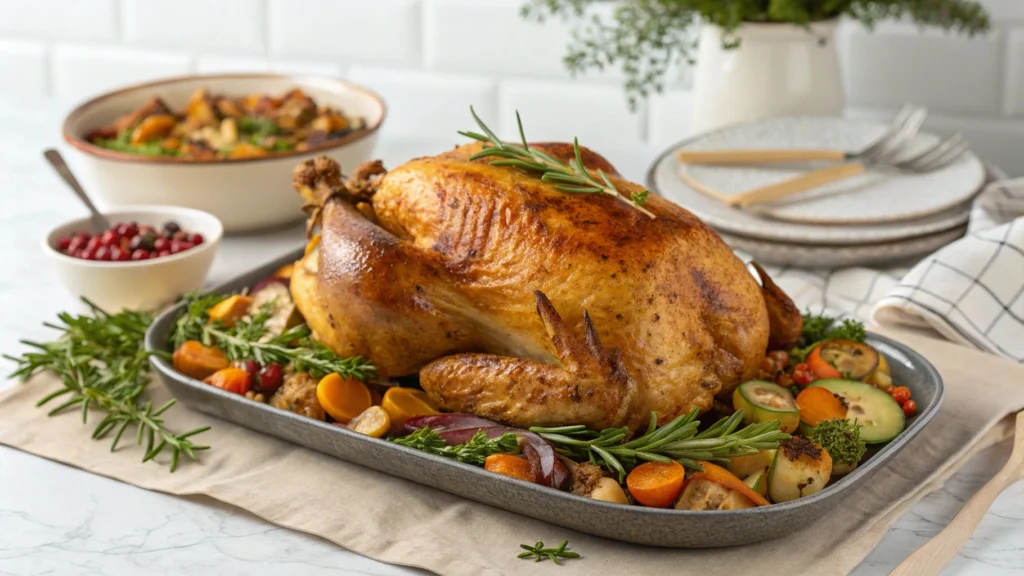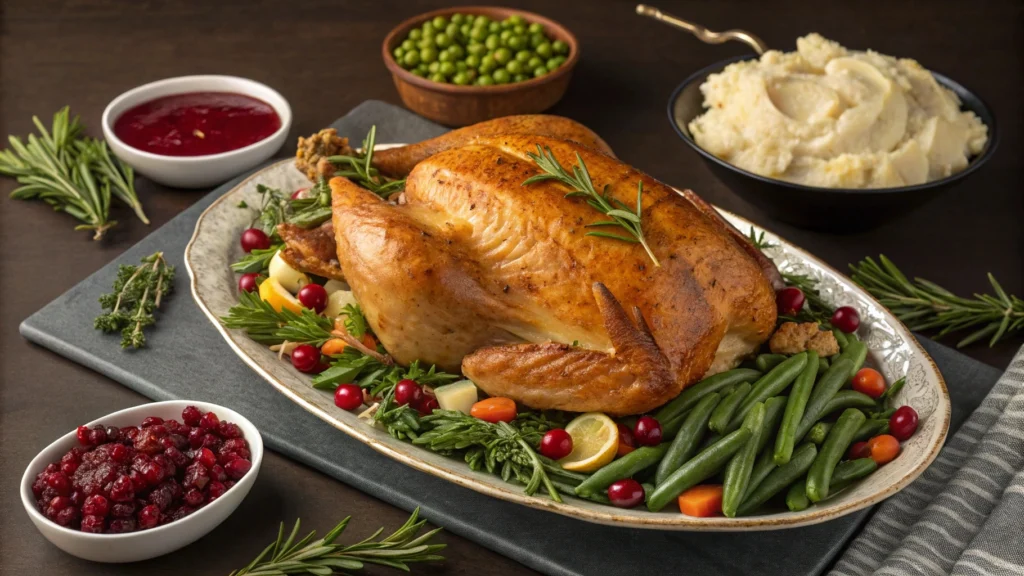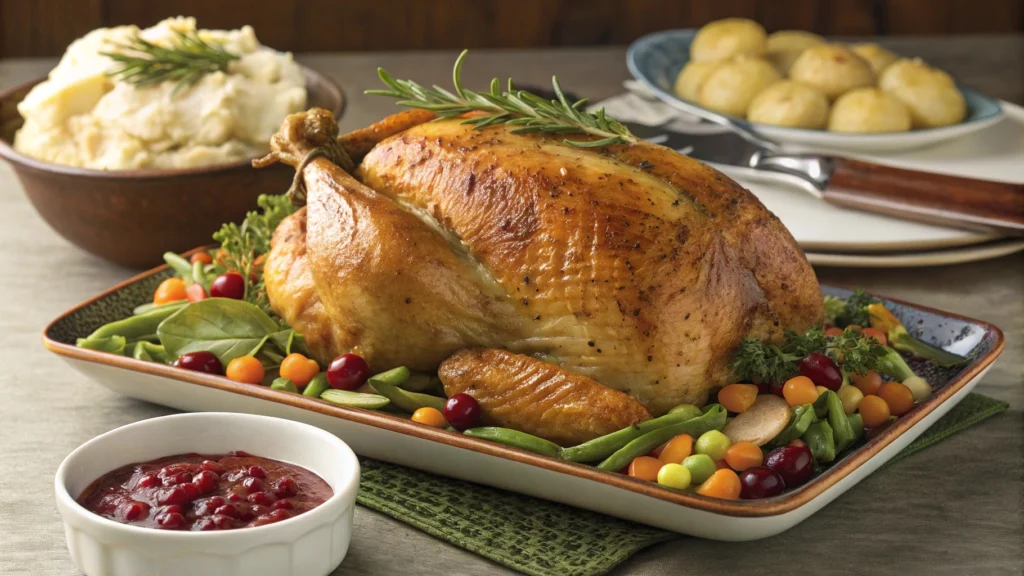Introduction: Why Cooking the Perfect Turkey Matters

There’s something magical about preparing a perfect turkey for a holiday meal. Whether it’s Thanksgiving, Christmas, or any family gathering, turkey has a way of bringing people together around the table. But let’s face it, the pressure to cook a turkey that’s both juicy and flavorful can be overwhelming. It’s a large bird, and the stakes are high – undercook it, and it’s raw; overcook it, and it’s dry. But with the right tips and techniques, you can confidently cook the perfect turkey every time.
In this guide, we’ll walk you through every step of the process – from choosing the right turkey to carving it at the table. By the end, you’ll feel like a seasoned pro and have a turkey that’s golden, juicy, and full of flavor. Let’s dive in!
Choosing the Right Turkey for Your Meal
Before you even turn on the oven, it’s essential to choose the right turkey for your meal. The quality of your bird can make all the difference in how your turkey turns out. Here are the key factors to consider:
Whole Turkey vs. Turkey Breast
- Whole Turkey: Cooking a whole turkey allows for that classic presentation, with crispy skin and juicy meat from both the breast and thighs. It’s ideal for larger gatherings.
- Turkey Breast: If you’re cooking for a smaller crowd or prefer leaner meat, a turkey breast might be the better choice. It cooks faster and is easier to carve.
Free-Range and Organic Turkeys
- Why It Matters: Free-range and organic turkeys often have more flavor and a better texture than conventionally raised birds. They tend to have more fat, which contributes to moisture during cooking.
Sizing Your Turkey
- How Much Turkey per Person: On average, you should plan for 1 to 1.5 pounds of turkey per person. If you’re serving a lot of side dishes or have light eaters, 1 pound per person should suffice.
Thawing Your Turkey
- Thawing Tips: If you’ve bought a frozen turkey, ensure you allow enough time to thaw it safely. The general rule is 24 hours of thawing time for every 5 pounds of turkey. Always thaw in the refrigerator, never on the counter.
Preparing Your Turkey for Roasting
Preparation is key to ensuring your turkey turns out perfectly. Here’s how to get your turkey ready for the oven:
Brining for Moisture
- Why Brining Matters: Brining helps the turkey absorb extra moisture, ensuring that it stays juicy during cooking. A simple saltwater brine will do the trick.
Seasoning and Stuffing
- Herbs and Spices: Season your turkey with a blend of herbs like rosemary, thyme, and sage. Fresh garlic and citrus fruits can also add a fragrant flavor to the meat.
- Stuffing: You can stuff your turkey with a mixture of bread cubes, vegetables, and herbs, though many chefs prefer to cook the stuffing separately to avoid overcooking the turkey.
Turkey Rubs and Marinades
- Rub for Flavor: A flavorful rub or marinade can make your turkey even tastier. Consider using olive oil, garlic, paprika, and mustard to create a flavorful crust.
Oiling or Buttering the Turkey
- Golden Skin: Apply a generous amount of butter or oil to the skin to ensure a golden, crispy exterior. Don’t forget to season the skin with salt and pepper.
Cooking Techniques for the Perfect Turkey
The cooking method you choose is essential in achieving that perfect turkey. Here’s how to cook it just right:
Roasting in the Oven
- Standard Roasting: The most common method is roasting in the oven at 325°F. Make sure your turkey is placed on a rack in a roasting pan to allow for even cooking.
Cooking Times Based on Weight
- How Long to Roast: Generally, you should roast your turkey for about 15 minutes per pound. For example, a 12-pound turkey will need approximately 3 hours to cook.
Basting the Turkey
- To Baste or Not to Baste: While it’s a common practice, basting isn’t always necessary. It can help the skin brown but may also cause the turkey to lose heat. You can baste every 30 minutes if you prefer.
Using a Turkey Thermometer
- Check the Temperature: The most reliable way to know your turkey is cooked is by using a thermometer. Insert it into the thickest part of the breast (165°F) and thigh (180°F) for perfect doneness.
Troubleshooting Common Turkey Cooking Issues
Even the most seasoned chefs encounter issues when cooking turkey. Here’s how to troubleshoot common problems:
What to Do if the Turkey is Dry
- Preventing Dryness: Dry turkey usually results from overcooking. Make sure to check the internal temperature and avoid cooking it past the ideal temperature.
Under-cooked Turkey
- Fixing Under-cooking: If your turkey is undercooked, return it to the oven immediately and check the temperature every 15 minutes.
Burnt Skin
- Preventing Over-browning: To avoid burnt skin, tent the turkey with foil if it’s browning too quickly. You can remove the foil during the last 30 minutes of cooking for a crisp finish.
How to Deal with Leftovers
- Ideas for Leftovers: After your meal, don’t let the turkey go to waste. Use leftovers for sandwiches, soups, casseroles, and even salads.

Carving and Serving Your Perfect Turkey
Now that your turkey is perfectly cooked, it’s time to carve and serve it. Follow these steps to ensure a flawless presentation:
How to Carve the Turkey
- Step-by-Step Guide: Start by removing the legs, then carve the breast meat by slicing against the grain. Don’t forget the wings and thighs!
Serving Tips
- Presentation: Arrange your turkey beautifully on a platter and garnish with fresh herbs and citrus slices for a festive look. Pair with classic sides like mashed potatoes, stuffing, and cranberry sauce.
Making Gravy from the Drippings
- Simple Gravy Recipe: Use the turkey drippings to make a rich gravy. Add flour to the drippings to thicken it, and season with salt and pepper for a flavorful sauce.
Storing Leftovers Properly
- Leftover Storage Tips: Store leftover turkey in airtight containers in the refrigerator for up to 3 days. For longer storage, freeze your turkey in portion-sized bags for future meals.
Choosing the Right Turkey for Your Meal
Heritage vs. Conventional Turkeys
- Heritage Turkeys: These birds come from traditional breeds and are known for their richer flavor and firmer texture. They’re more expensive but can be a show-stopping centerpiece.
- Conventional Turkeys: Commonly found in grocery stores. They are plump, affordable, and typically bred for more white meat. Good choice for large crowds.
Quick Table: Turkey Type Comparison
| Turkey Type | Flavor Profile | Texture | Cost | Ideal For |
|---|---|---|---|---|
| Conventional | Mild, familiar | Tender | $ | General meals, big gatherings |
| Organic | Cleaner, slightly richer | Juicier | $$ | Health-conscious eaters |
| Free-Range | Slightly gamey | Firmer | $$$ | Flavor-focused cooks |
| Heritage | Deep, rich | Chewy (in a good way) | $$$$ | Gourmet and traditional menus |
Preparing Your Turkey for Roasting
Dry Brine vs. Wet Brine – Which is Better?
- Wet Brine: Involves soaking the turkey in a saltwater solution for 12–24 hours. Adds moisture and infuses flavor.
- Dry Brine: Rubbing salt and spices directly onto the turkey and letting it sit uncovered in the fridge. Yields crispier skin and concentrated flavor.
Expert Tip: If you want maximum crispiness with deep flavor, go for a dry brine.
Aromatics for Inside the Cavity
Stuff the cavity with fresh aromatics (if not using stuffing) to infuse subtle flavors during roasting:
- Onion quarters
- Garlic cloves
- Lemon halves
- Apple slices
- Fresh herbs (thyme, sage, rosemary)
Butter Compound for Under the Skin
Mix softened butter with chopped herbs, garlic, and citrus zest. Carefully loosen the turkey skin and spread the butter underneath for extra flavor and moisture.
Cooking Techniques for the Perfect Turkey (continued)
Convection Oven Tips
- Pro: Shorter cooking time and crispier skin.
- Con: Risk of drying out if you don’t monitor closely.
- Lower oven temperature by 25°F when using convection.
Spatchcocking Your Turkey
This method involves removing the backbone and flattening the bird for even, faster cooking.
- Reduces cooking time by 30–40%.
- Ensures crispy skin all over and juicier meat.
Resting the Turkey – A Must!
Let your cooked turkey rest for at least 20–30 minutes before carving. This allows juices to redistribute, making the meat more tender and flavorful.

Troubleshooting Common Turkey Cooking Issues
The Skin is Too Pale
- Crank up the heat to 425°F for the last 15–20 minutes of roasting.
- Brush with butter or oil before returning it to the oven.
My Turkey Isn’t Done but Skin Is Browning Too Fast
- Loosely tent the turkey with foil to prevent burning while the inside finishes cooking.
How to Rescue Dry Turkey
- Slice the meat thinly and pour warm broth or gravy over it before serving.
- Store leftovers in broth-filled containers to rehydrate later.
Turkey Cooking Time Table (Oven at 325°F)
| Turkey Weight | Cooking Time (Unstuffed) | Cooking Time (Stuffed) |
|---|---|---|
| 8-12 lbs | 2.75 to 3 hours | 3 to 3.5 hours |
| 12-14 lbs | 3 to 3.75 hours | 3.5 to 4 hours |
| 14-18 lbs | 3.75 to 4.25 hours | 4 to 4.25 hours |
| 18-20 lbs | 4.25 to 4.5 hours | 4.25 to 4.75 hours |
| 20-24 lbs | 4.5 to 5 hours | 4.75 to 5.25 hours |
Carving and Serving Your Perfect Turkey (continued)
How to Carve Like a Pro
- Remove the Legs: Cut through the skin between leg and body, then joint.
- Separate Thigh and Drumstick: Cut at the joint.
- Take Off the Wings: Twist and pull at the joints.
- Slice the Breast: Cut parallel to the breastbone, then into thin slices.
Side Dish Suggestions
- Creamy mashed potatoes
- Green bean almondine
- Cranberry-orange relish
- Roasted Brussels sprouts with pancetta
- Buttery dinner rolls
Quick Gravy from Pan Drippings
Ingredients:
- Pan drippings (strained)
- 2 tbsp flour
- 2 tbsp butter
- 2 cups turkey/chicken broth
- Salt, pepper to taste
Steps:
- Melt butter in a pan, stir in flour to make a roux.
- Slowly whisk in broth and drippings.
- Simmer until thickened.
Advanced Tips for Elevating Your Turkey Game
Dry-Aging Your Turkey for Flavor
If you have time and fridge space, dry-aging your turkey (unwrapped on a rack in the fridge for 2–3 days) can:
- Intensify flavor
- Help dry out the skin (for max crispiness)
- Improve texture
Just be sure the bird is in a well-ventilated fridge and away from other foods to avoid cross-contamination.
Injecting Marinade
Using a flavor injector lets you add flavor inside the meat. Try a mix of:
- Melted butter
- Garlic
- Fresh herbs
- Chicken or turkey stock
- A splash of citrus juice (like lemon or orange)
Inject it deep into the breast and thighs before roasting.
Flavor Profile Ideas by Theme
| Theme | Spices & Aromatics | Ideal Side Pairings |
|---|---|---|
| Classic Herb | Sage, rosemary, thyme, garlic | Mashed potatoes, gravy, green beans |
| Cajun/Spicy | Cajun seasoning, smoked paprika, cayenne | Cornbread, collard greens, mac n’ cheese |
| Citrus & Herb | Lemon zest, orange, parsley, thyme | Couscous, asparagus, fennel salad |
| Middle Eastern | Za’atar, sumac, garlic, olive oil | Herbed rice, pomegranate salad |
| Asian-Inspired | Soy sauce, ginger, garlic, sesame oil | Sticky rice, stir-fried greens |
Alternatives to Roasting (For Small Kitchens or Adventurous Cooks)
Deep-Fried Turkey
- Cook Time: 3–4 minutes per pound
- Result: Incredibly juicy meat, super crispy skin
- Warning: Do not do this indoors. Use a deep fryer outdoors with proper equipment and fire safety.
Pro Tip: Always thaw completely before frying to prevent dangerous oil splatter.
Slow Cooker Turkey Breast
- Perfect for small households or Friendsgiving meals.
- Season a bone-in breast and let it cook low and slow (6–7 hours).
- Use the drippings to make a rich gravy.
Sous Vide Turkey
- Ultra-precise cooking method.
- Vacuum seal seasoned turkey parts, cook at 145°F for 4–6 hours.
- Finish with a hot oven blast or torch for crispy skin.
Leftovers Reimagined – Creative Recipes You’ll Crave
Don’t let a single bite go to waste! Here are some creative ways to transform your turkey leftovers:
Turkey Pot Pie
- Use turkey, leftover veggies, and gravy under a golden pastry crust. Comfort food at its best.
Turkey Ramen Bowl
- Add shredded turkey to a bowl of hot broth, noodles, soft egg, and greens. Cozy, savory, satisfying.
Thanksgiving Grilled Cheese
- Stuff sourdough bread with turkey, cranberry sauce, and cheese. Grill until gooey and golden.
Turkey Fried Rice
- Toss diced turkey with cold rice, soy sauce, sesame oil, egg, and scallions. Quick and delicious.
Turkey & Sweet Potato Hash
- Sauté chopped turkey with leftover roasted sweet potatoes, onions, and herbs. Top with a fried egg.
Turkey Planning Timeline – Countdown to the Big Day
Here’s a sample timeline to help you stay calm and organized:
| Days Before | What to Do |
|---|---|
| 7 Days | Buy your turkey (especially if frozen) |
| 4–5 Days | Start thawing in the fridge (24 hrs/5 lbs) |
| 3 Days | Dry-brine or start wet brining |
| 2 Days | Prepare compound butter and stuffing |
| 1 Day | Prep roasting pan, chop aromatics, dry skin |
| Day Of | Cook, rest, carve, and serve! |
Bonus Tip: Set multiple timers—one for basting, one for checking internal temps, one for side dishes!

Conclusion
Congratulations – you now know how to make the perfect turkey every time! By following these steps, choosing the right bird, preparing it carefully, and mastering the cooking techniques, you can serve up a turkey that’s golden, juicy, and full of flavor. Don’t be afraid to experiment with different methods and flavors to make your turkey your own.
Remember, cooking is about having fun, so enjoy the process, and don’t hesitate to share your own tips or ask questions in the comments below. Happy cooking!
FAQ: How to cook turkey
How long should I cook my turkey?
- For a standard 325°F oven temperature, plan for approximately 15 minutes per pound of turkey. A 12-pound turkey would need about 3 hours.
How do I know when my turkey is done?
- Use a meat thermometer to check the internal temperature. The turkey breast should reach 165°F, while the thighs should reach 180°F.
Can I cook my turkey the night before?
- While it’s best to cook your turkey on the day of your meal, you can roast it the night before and reheat it in the oven with a bit of broth to maintain moisture.
What’s the best way to carve a turkey?
- Carve the legs first, followed by the breast. Slice against the grain for tender, juicy slices.
How do I make gravy from turkey drippings?
- Simply strain the drippings, add flour to create a roux, and season with salt and pepper. Add turkey stock or water for the perfect consistency.
